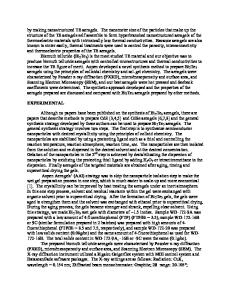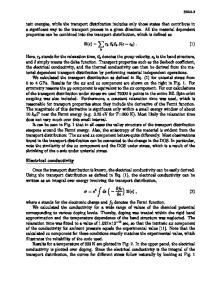Thermomechanical Characterization of Bismuth Telluride Based Thermoelectric Materials
- PDF / 137,815 Bytes
- 6 Pages / 612 x 792 pts (letter) Page_size
- 28 Downloads / 380 Views
Thermomechanical Characterization of Bismuth Telluride Based Thermoelectric Materials Witold Brostow1, Kevin P. Menard2 and John B. White Marlow Industries, Inc., 10451 Vista Park Road, Dallas, TX 75238-3334 1 Laboratory of Advanced Polymers & Optimised Materials (LAPOM), Department of Materials Science, University of North Texas, P.O. Box 305310, Denton, TX 76203-5310 2 PerkinElmer Instruments, 710 Bridgeport Ave, MS F71, Shelton, CT 06484-4796 ABSTRACT The thermoelectric properties of bismuth telluride based thermoelectric (TE) materials are well-characterized, but comparatively little has been published on the mechanical and thermomechanical properties of these materials. In this paper, we present the initial dynamic mechanical analysis (DMA) data for n-type and p-type bismuth telluride based TE materials. The materials' tan δ values, indicative of viscoelastic energy dissipation modes, approach that of glassy or crystalline polymers and are greater than ten times the tan delta of structural metals. TE samples measured perpendicular to the van der Waals planes have higher tan δ values. Thermal scans in the DMA compressive mode showed changes in mechanical properties versus temperature with clear hysteresis effects. These changes were correlated to differential scanning calorimetry (DSC) thermal transitions. The expected anisotropy was shown in flexural 3-point bending results for one n-type material that showed a storage modulus of 0.10 to 0.45 GPa in the direction parallel to the van der Waals planes and 0.07 to 0.2 GPa in the perpendicular direction. INTRODUCTION Bismuth telluride based thermoelectric (TE) materials are relatively soft, brittle polycrystalline materials. Nolas, Sharp and Goldsmid [1] give several formulas for typical pseudoternary TE materials. A typical n-type TE material is Bi2Te3-ySey and a typical p-type material is Bi2-xSbxTe3. The exact compositions of the materials used in these analyses were not quantified. With structures ranging from mica-like to sandstone-like depending on the processing conditions, TE materials exhibit varying degrees of anisotropic thermoelectric and mechanical behavior [2]. The thermoelectric properties of these materials are well-characterized, but relatively little has been published on the mechanical and thermomechanical properties of these pseudo-ternary materials. Therefore thermomechanical techniques are of interest as possible tools for characterization of TE materials. Understanding the mechanical and thermomechanical properties of TE materials is useful and often necessary in modeling the TE material interaction with other materials used in the TE cooler assembly. In addition, determination of the dynamic moduli with dynamic mechanical analysis (DMA) can provide information about the structure of the material. DMA is of interest due to the relative ease of use, the ability to measure mechanical properties as a function of temperature and frequency, and the potential to measure assembled thermoelectric coolers as well as individual materials. The measuring
Data Loading...











